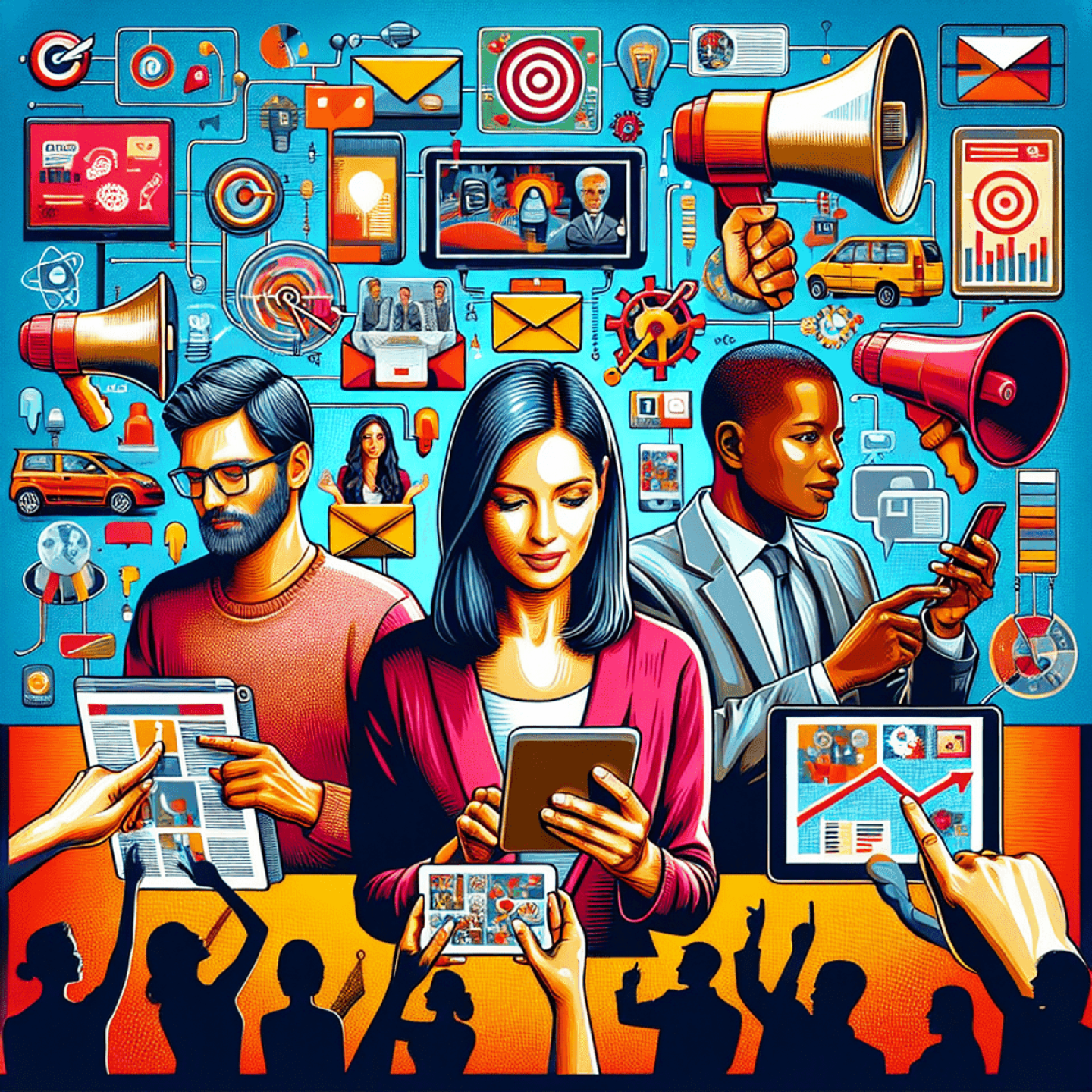
Our spy tools monitor millions of native ads from over 60+ countries and thousands of publishers.
Get StartedNative advertising is a strategic approach that involves creating ads that are so cohesively blended with the page content, assimilated into the design, and consistent with the platform behavior that the viewer feels the ad belongs there. This seamless integration captures the audience's attention without interrupting their browsing experience. Personalization is at the heart of this advertising model, as it tailors the advertising message to individual user preferences and behaviors.
The impact of personalization on native advertising engagement cannot be overstated. When ads resonate with users on a personal level, they are more likely to engage with the content, leading to increased brand loyalty and conversion rates. By considering user data like browsing habits, interests, and past interactions, advertisers can create a native ad experience that feels custom-made for each user.
For marketers aiming to master native advertising engagement through personalization, tools like Anstrex Native provide valuable insights into competitive campaigns which can inform smarter ad strategies. Anstrex allows you to spy on profitable native ads and build winning native advertising campaigns today by learning from your competition. Personalized native ads not only boost user engagement but also enhance the overall user experience by delivering relevant and interesting content that adds value rather than
Native advertising engagement refers to the level of interaction that users have with native ads - advertisements that seamlessly blend in with the platform they are presented on. These could be social media feeds, news websites, or mobile apps. The goal is to provide a non-disruptive and immersive experience that resonates with the user's interests and preferences, leading to increased interaction and higher conversion rates.
The advertising landscape has dramatically evolved due to technological advancements and changing consumer behavior. Traditional forms of advertising are now being overshadowed by more dynamic and user-centric models like native advertising.
Engagement is a critical metric in this landscape. It's no longer just about reaching a broad audience; it's about reaching the right audience and compelling them to interact with your ad. High engagement signifies that your content is appealing and relevant to your target audience, which ultimately drives better ad performance.
In the context of native advertising, personalization is a key factor that can significantly enhance user engagement. By aligning ads with consumers' preferences and browsing behavior, marketers can capture their attention effectively without being intrusive.
Key Takeaway: Personalization transforms native ads into targeted messages that speak directly to the individual user. This approach fosters an intuitive user journey, where the line between content and advertisement is blurred. Not only does this increase the likelihood of engagement, but it also enhances the overall user experience on the platform.
Personalization is a strategy that tailors content and experiences to individual users based on their behaviors, interests, and demographic information. In the realm of native advertising, personalization means crafting ad experiences that not only blend seamlessly with the platform's regular content but also resonate with the individual user's needs and preferences.
Achieving this level of personalization requires understanding your audience at a granular level. Analyzing data on user behavior, browsing history, and demographic factors can help you tailor your native ads to match each user's unique preferences.
In the world of personalized native advertising, technology plays a crucial role. It's no secret that making advertising campaigns reach a large audience and be relevant to them is a difficult task. But thanks to advancements in technology, this has become easier than ever.
One important factor in this technological change is Artificial Intelligence (AI). AI helps marketers understand their audience better. It can analyze large amounts of data, finding patterns and trends that human analysts might miss.
Machine Learning (ML), a subset of AI, takes these abilities even further. ML algorithms learn from past data, constantly getting better at predicting and making decisions over time. In the case of native advertising, they can be used to change ad elements based on observed user behavior patterns.
Native advertising platforms are using these advanced technologies to provide highly personalized ad experiences on a large scale. They offer solutions for managing data, categorizing audiences, and optimizing ad delivery.
For example, Emodo's Adapt solution uses information from mobile operators to gain dynamic insights into consumer behavior and preferences. This makes it easier to create native ads that are highly relevant and interesting to users.
Key takeaway: Technological improvements, especially in AI and ML, are very important for making personalized native advertising campaigns possible. By using the advanced solutions provided by native advertising platforms, marketers can effectively create and optimize personalized ads that get more attention.
In the world of native social display advertising, collecting and analyzing data is crucial for a successful campaign. By continuously gathering, studying, and refining data, marketers can learn about their audience's behavior, preferences, and interests.
Video content is a prime example of this. It's an incredibly effective way to grab attention and connect with users. By examining how users react to different aspects of videos - like the story or length - we can discover valuable insights. These insights can then be used to create more compelling and engaging native ads.
This is where AI and machine learning technology comes in. It's not just about crunching numbers; it's about understanding data in ways that humans can't. With AI algorithms, we can analyze large amounts of data to find subtle patterns in user behavior. We can then use these patterns to automatically optimize ad elements such as headlines, images, or calls-to-action.
Key takeaway: AI and machine learning are essential tools for personalizing native advertising on a large scale. By using these technologies effectively, marketers can ensure that their native ads always resonate with their audience, leading to higher user engagement and better campaign performance.
When it comes to native advertising, customization of ad creatives is crucial for making a strong impression and generating interest. There are several key areas that require careful attention:
Metadata refers to the hidden data that provides information about your content to search engines and algorithms. It's important to ensure that your metadata accurately reflects the topics and interests of your target audience, including relevant keywords for better visibility.
Headlines play a vital role in grabbing attention and enticing users to click on your native ads. Here are some tips for creating compelling headlines:
Images have the power to capture attention instantly. When choosing images for your native ads, keep these points in mind:
The content within your ad should provide value to the viewer. Here's how you can tailor your content for maximum impact:
Identifying which segments of your audience respond best to specific personalization strategies allows you to focus your efforts where they will have the greatest impact. This targeted approach is crucial for effective personalization in native advertising, as it ensures relevance, connection, and ultimately, conversion.
A successful native advertising strategy doesn't stop at personalization. It extends to a user's entire journey, ensuring a consistency in messaging and design across all touchpoints. This adherence to consistency transforms a user's interaction with your brand into an experience--one that remains uniform, regardless of the platform or device they use.
Ad type selection is paramount. Different ad types resonate differently across various platforms and devices. For instance, video ads may work exceptionally well on mobile devices but may not generate the same engagement on desktops. Therefore, it's essential to customize your ad type based on the platform for optimal results.
Next in line is creative development. Your creative elements - be it text, images, or videos - should reflect the core values and aesthetics of your brand consistently. The aim is to create a sense of familiarity and trust among your users, which eventually leads to higher engagement.
To ascertain the effectiveness of your personalization efforts and ensure consistency, A/B testing proves invaluable. By simultaneously testing two versions of an ad, you get real-time insights into what works best for your target audience. It allows you to optimize ad performance by identifying winning elements that lead to increased engagement rates.
Remember, consistency is not about repetition; it's about creating a seamless user experience that echoes your brand's identity across all touchpoints.
As the impact of personalization on native advertising engagement grows, so does the need for ethical considerations. One such consideration is addressing privacy concerns. Users share sensitive information online, and it's essential for advertisers to respect this by ensuring that their data collection and usage practices are transparent and ethical.
Privacy concerns can be mitigated by providing clear information about what data is being collected, how it's being used, and who it's being shared with. Users should also have the option to opt out of data collection or adjust their privacy settings at any time.
Another key ethical consideration is balancing personalization with respect for user privacy. While personalization can improve user experience and engagement, it shouldn't come at the cost of user privacy.
Users are more likely to engage with ads that respect their privacy, leading to long-term success in native advertising. Therefore, striking a balance between delivering personalized ad experiences and respecting user privacy is crucial.
The world of digital advertising is always changing, and native advertising is leading the way in this transformation. New technologies and formats are constantly emerging, opening up possibilities for even more advanced personalized ad experiences. Here's what we can expect to see in the future:
Native ads will become more interactive, allowing users to engage in fun and informative ways. This could include things like:
These interactive elements will invite users to immerse themselves in a brand's world and create a stronger connection.
With the increasing popularity of smart speakers and voice search, native ads may soon be integrated into voice-activated content. This means that instead of reading or watching an ad, users will be able to listen to it through their devices. This seamless experience will fit into the user's lifestyle and preferences, making it feel more natural and less intrusive.
Advertisers will use predictive analytics to not only understand what consumers are currently doing but also predict what they will do in the future. By having this insight, advertisers can create messages that resonate on a deeper level with their target audience.
Blockchain technology could be used to improve transparency in how personal data is used in native advertising. This would give consumers more control over their information and provide reassurance about their privacy.
Artificial intelligence (AI) will play a significant role in content creation for native advertising. It will be able to generate personalized stories on a large scale that align with individual preferences and cultural nuances. This means that brands can deliver tailored messages to their audience without having to manually create each piece of content.
Personalization is now an essential part of native advertising strategies. As brands look for ways to stand out in a crowded market, these future trends will give them the tools they need to create engaging ad experiences for each person. Brands that embrace these changes will likely see better results and build stronger connections with their audiences.
Use the power of personalization to completely change how you engage with native advertising. In a crowded digital world, it's no longer enough to just stand out—you need to be unique. Personalized native ads allow you to form genuine connections with your audience, creating engagement that truly matters.
Personalization in native advertising is more than just a passing fad—it's the foundation of modern marketing strategies that aim for relevance and effectiveness. Take this opportunity to explore, refine, and see how personalization can unlock the true potential of your advertising efforts.
Receive top converting landing pages in your inbox every week from us.
How-To
Native ads can do more than drive clicks—they can build long-term brand loyalty. Learn how to use authentic storytelling, strategic placement, and audience targeting to strengthen trust during year-end campaigns. Discover how subtle, value-driven messaging keeps customers engaged beyond the holidays. Ideal for marketers aiming to turn seasonal buyers into loyal brand advocates.
Marcus Chen
7 minDec 15, 2025
Must Read
As third-party cookies fade away, contextual targeting is making a powerful comeback. Learn how to leverage native ads that align with user intent and content relevance to maintain high engagement and conversions. Discover modern tools and tactics that make cookie-free targeting both precise and scalable. Ideal for advertisers seeking privacy-friendly ways to drive performance in 2025 and beyond.
Liam O’Connor
7 minDec 9, 2025
Recently Updated
Native ads can make or break your holiday marketing success. Explore how to evaluate your recent campaigns and identify what worked—or what fell short—with native advertising. Learn key optimization tactics to boost engagement, strengthen audience trust, and increase conversions in future promotions. Ideal for marketers aiming to refine their ad strategies after the holiday rush.
Elena Morales
7 minDec 1, 2025




